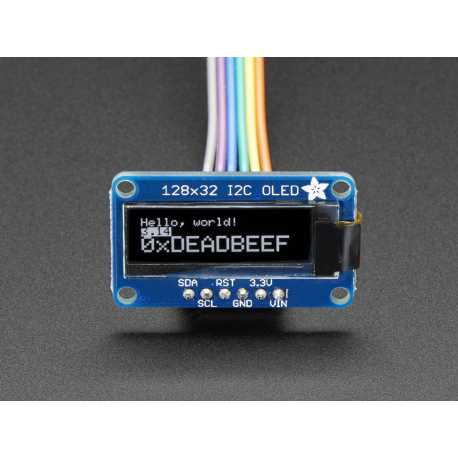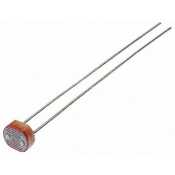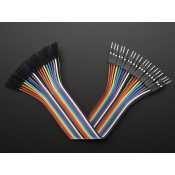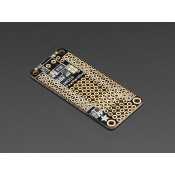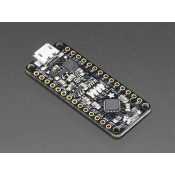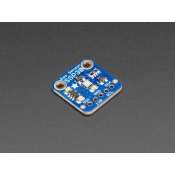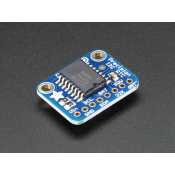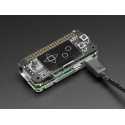Customers who bought this product also bought:
- Spool of thread thin 2 strands stainless - 23 m
- LDR - Photoresistor
- 20 Male - female 150mm Premium dupont wires Kit
- Adafruit INA219 FeatherWing
- Adafruit Metro Mini 328 - 5V 16MHz
- Adafruit FLORA v3
- Adafruit SGP30 Air Quality Sensor Breakout - VOC and eCO2
- Adafruit DS3231 RTC Breakout Precision
- Breadboard-friendly RGB Smart NeoPixel - Pack of 4
More info
These displays are small, only about 1" diagonal, but very readable due to the high contrast of an OLED display. This display is composed of 128x32 individual white OLED pixels, each one being turned on or off by the controller chip. Since the display produces its own light, no backlighting is required. This reduces the power required to operate the OLED and that's why the screen is so contrasting; we really like this miniature screen for its sharpness!
The SSD1306 driver chip, communicates only via I2C. 3 pins are required to communicate with the chip on the OLED display, two of which are I2C clock/data pins.
The OLED and the pilot require a 3.3 V power supply and 3.3 V logic levels for communication. To make it easier for our customers to use, we have added a 3.3 V regulator and an on-board level adapter! This makes it compatible with any 5V microcontroller, such as the Arduino.
The power requirements depend somewhat on the amount of power on the display, but on average, the display consumes about 20 mA from the 3.3 V power supply. The OLED pilot integrates a simple charging pump that transforms 3.3v-5v into a high voltage drive for OLEDs.
Of course, we wouldn't leave you with a data sheet and "good luck": We have a detailed tutorial and sample code in the form of an Arduino library for text and graphics. You will need a microcontroller with more than 512 bytes of RAM because the screen must be buffered.
You can download our SSD1306 OLED display library Arduino from github which contains a sample code. The library can print text, bitmaps, pixels, rectangles, circles and lines. It uses 512 bytes of RAM since it needs to buffer all the display but it's very fast! The code is easy to adapt to any other microcontroller.
Feature
These displays are small, only about 1" diagonal, but very readable due to the high contrast of an OLED display. This display is composed of 128x32 individual white OLED pixels, each one being turned on or off by the controller chip. Since the display produces its own light, no backlighting is required. This reduces the power required to operate the OLED and that's why the screen is so contrasting; we really like this miniature screen for its sharpness!
The SSD1306 driver chip, communicates only via I2C. 3 pins are required to communicate with the chip on the OLED display, two of which are I2C clock/data pins.
The OLED and the pilot require a 3.3 V power supply and 3.3 V logic levels for communication. To make it easier for our customers to use, we have added a 3.3 V regulator and an on-board level adapter! This makes it compatible with any 5V microcontroller, such as the Arduino.
The power requirements depend somewhat on the amount of power on the display, but on average, the display consumes about 20 mA from the 3.3 V power supply. The OLED pilot integrates a simple charging pump that transforms 3.3v-5v into a high voltage drive for OLEDs.
Of course, we wouldn't leave you with a data sheet and "good luck": We have a detailed tutorial and sample code in the form of an Arduino library for text and graphics. You will need a microcontroller with more than 512 bytes of RAM because the screen must be buffered.
You can download our SSD1306 OLED display library Arduino from github which contains a sample code. The library can print text, bitmaps, pixels, rectangles, circles and lines. It uses 512 bytes of RAM since it needs to buffer all the display but it's very fast! The code is easy to adapt to any other microcontroller.
Documentation
Accessories

OLED display monochrome 1.3 "128 x 64 graphic
A screen OLED monochrome 1.3 "128 x 64 graphic SPI or I2C.
23,94 € Add to cart
Adafruit PiOLED - 128x32 Monochrome OLED for Raspberry PI
A small OLED screen that connects to the GPIO port of the Raspberry PI in I2C.
17,94 € Add to cart- 27,00 € Add to cart

Adafruit SHARP Memory Display Breakout - 1.3" 168x144 Monochrome
A Sharp Memory LCD screen between E-ink and LCD monitor.
29,94 € Add to cart

